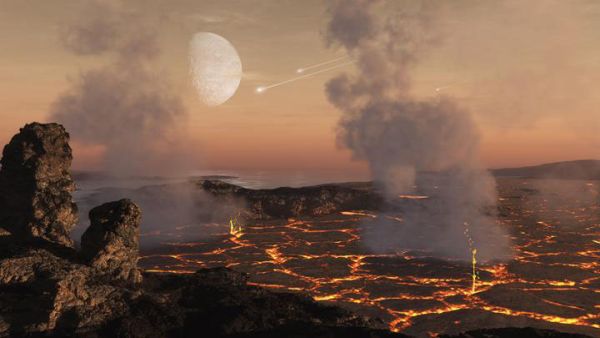City-sized asteroids smacked ancient Earth 10 times more often than thought
Tiny bubbles in rocks suggest that ancient Earth was frequently battered by giant asteroids.

Asteroids the size of cities, like the one that wiped out the dinosaurs, slammed into the ancient Earth way more often than previously thought, a new study has found.
Approximately every 15 million years, our evolving planet would get a hit by a piece of rock about the size of a city, or even a bigger province, scientists with the new study said in a statement. The research was presented at the Goldschmidt geochemistry conference this month.
This violent period, which took place between 2.5 and 3.5 billion years ago, saw the planet in upheaval on a regular basis, with the chemistry near its surface undergoing dramatic changes that can be traced in the rocks in the ground even today, the researchers said.
In the study, Simone Marchi a principal scientist with the Southwest Research Institute in Boulder, Colorado and colleagues looked at the presence of the so-called spherules, small bubbles of vaporized rock that were thrown up to space by every asteroid impact, but then solidified and fell back to Earth, forming a thin layer that geologists see in the bedrock today.
Related: Saturn could be defending Earth from massive asteroid impacts
The team developed a new method to model the effect of asteroid impacts in terms of their ability to generate spherules and affect their global distribution. The bigger the asteroid, the thicker the layer of spherules in the rock should be. But when the researchers looked at the actual amount of spherules in the different layers of the bedrock and compared it with current estimates of past asteroid impacts, they found the two values did not match.
"We found that current models of Earth's early bombardment severely underestimate the number of known impacts, as recorded by spherule layers," Marchi said in the statement. "The true impact flux could have been up to a factor of 10 times higher than previously thought in the period between 3.5 and 2.5 billion years ago."
Sign up for the Live Science daily newsletter now
Get the world’s most fascinating discoveries delivered straight to your inbox.
Those past asteroid strikes may also have affected the oxygen levels and the ability of the young planet to support life.
"We find that oxygen levels would have drastically fluctuated in the period of intense impacts," Marchi said. "Given the importance of oxygen to the Earth's development, and indeed to the development of life, its possible connection with collisions is intriguing and deserves further investigation. This is the next stage of our work."
According to Rosalie Tostevin, of the University of Cape Town, who was not involved in the study but specializes in ancient geology, some chemical markers point towards the existence of "whiffs" of oxygen in the early atmosphere, before a permanent rise that occurred around 2.5 billion years ago.
"There is considerable debate surrounding the significance of these whiffs, or indeed, whether they occurred at all," Tostevin said in the statement. "We tend to focus on the Earth's interior and the evolution of life as controls on Earth's oxygen balance, but bombardment with rocks from space provides an intriguing alternative."

Rocky bodies without an atmosphere, such as the moon, carry a detailed record of past asteroid impacts. On a planet like Earth, with varied weather patterns and geological activity, the traces of many of the past impacts have long been erased. It took until the late 1970s for scientists to discover the Chicxulub impact crater in Mexico. It took a further few years for them to identify this impact as the cause of the extinction of dinosaurs.
"These large impacts would certainly have caused some disruption," Tostevin said. "Unfortunately, few rocks from this far back in time survive, so direct evidence for impacts, and their ecological consequences, is patchy. The model put forward by Dr. Marchi helps us to get a better feel for the number and size of collisions on the early Earth."
Follow Tereza Pultarova on Twitter @TerezaPultarova. Follow us on Twitter @Spacedotcom and on Facebook.











